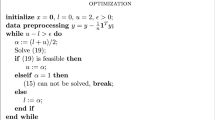Abstract
A high performance adaptive fidelity approach for multi-modality Optic Nerve Head (ONH) image fusion is presented. The new image fusion method, which consists of the Adaptive Fidelity Exploratory Algorithm (AFEA) and the Heuristic Optimization Algorithm (HOA), is reliable and time efficient. It has achieved an optimal fusion result by giving the visualization of fundus image with a maximum angiogram overlay. Control points are detected at the vessel bifurcations using the AFEA. Shape similarity criteria are used to match the control points that represent same salient features of different images. HOA adjusts the initial good-guess of control points at the sub-pixel level in order to maximize the objective function Mutual-Pixel-Count (MPC). In addition, the performance of the AFEA and HOA algorithms was compared to the Centerline Control Point Detection Algorithm, Root Mean Square Error (RMSE) minimization objective function employed by the traditional Iterative Closest Point (ICP) algorithm, Genetic Algorithm, and some other existing image fusion approaches. The evaluation results strengthen the AFEA and HOA algorithms in terms of novelty, automation, accuracy, and efficiency.












Similar content being viewed by others
References
Wong, A., & Orchard, J. (2009). Robust multimodal registration using local phase-coherence representations. Journal of Signal Processing Systems, 54(1–3), 89–100.
Yang, G., Stewart, C., Sofka, M., & Tsai, C. (2007). Registration of challenging image pairs: initialization, estimation, and decision. IEEE Transactions on Pattern Analysis and Machine Intelligence, 29(11), 1973–1989.
Woo, J., Hong, B., Hu, C., Shung, K., Kuo, C., & Slomka, P. (2009). Non-rigid ultrasound image registration based on intensity and local phase information. Journal of Signal Processing Systems, 54(1–3), 33–43.
Loeckx, D., Slagmolen, P., Maes, F., Vandermeulen, D., & Suetens, P. (2010). Nonrigid image registration using conditional mutual information. IEEE Transactions on Medical Imaging, 29(1), 19–29.
Estevez, P., Tesmer, M., Perez, C., & Zurada, J. (2009). Normalized mutual information feature selection. IEEE Transactions on Neural Networks, 20(2), 189–201.
Lin, F., & Olivo, M. (2009). Guest editors’ comments; the state-of-the-art technologies for medical and biological imaging. Journal of Signal Processing Systems, 54(1–3), 1–6.
Stewart, C., Tsai, C., & Roysam, B. (2003). The dual-bootstrap iterative closest point algorithm with application to retinal image registration. IEEE Transactions on Medical Imaging, 22(11), 1379–1394.
Canny, J. (1986). A computational approach to edge detection. IEEE Transactions on Pattern Analysis and Machine Intelligence, 8, 679–698.
Chen, X., Yang, J., Zhang, J., & Waibel, A. (2002). Automatic detection of signs with affine transformation. 6th IEEE Workshop on Applications of Computer Vision, 32–36.
Khoobehi, B., Beach, J., & Kawano, H. (2004). Hyperspectral imaging for measurement of oxygen saturation in the optic nerve head. Investigative Ophthalmology & Visual Science, 45, 1464–1472.
Beach, J., Ning, J., & Khoobehi, B. (2007). Oxygen saturation in optic neve head structures by hyperspectral image analysis. Current Eye Research, 32, 161–170.
Otsu, N. (1979). A threshold selection method from gray-level histograms. IEEE Transactions on Systems, Man, and Cybernetics, 9, 62–66.
Sezgin, M., & Sankur, B. (2004). Survey over image thresholding techniques and quantitative performance evaluation. Journal of Electronic Imaging, 13, 146–165.
Chaudhuri, S., Chatterjee, S., & Katz, N. (1989). Detection of blood vessels in retinal images using two-dimensional matched filters. IEEE Transactions on Medical Imaging, 8, 263–269.
Can, A., Shen, H., Turner, J. N., Tanenbaum, H. L., & Roysam, B. (1999). Rapid automated tracing and feature extraction from retinal fundus images using direct exploratory algorithms. IEEE Transactions on Information Technology in Biomedicine, 3, 125–138.
Poli, R., & Valli, G. (1996). An algorithm for real-time vessel enhancement and detection. Computer Methods and Programs in Biomedicine, 52, 1–22.
Antania, S., Leeb, D., Longa, R., & Thoma, G. (2004). Evaluation of shape similarity measurement methods for spine x-ray images. Journal of Visual Communication and Image Representation, 15, 285–302.
Arkin, E. M., Chew, L. P., Huttenlocher, D. P., Kedem, K., & Mitchell, J. (1991). An efficiently computable metric for comparing polygonal shapes. IEEE Transactions on Pattern Analysis and Machine Intelligence, 13(3), 209–216.
Avis, D., & ElGindy, H. (1983). A combinatorial approach to polygon similarity. IEEE Transactions on Information Theory, IT-2, 148–150.
Zhu, Y. (2007). Mutual information-based registration of temporal and stereo retinal images using constrained optimization. Computer Methods and Programs in Biomedicine, 86, 210–215.
Matsopoulos, G., Mouravliansky, N., & Delibasis, K. (1999). Automatic retinal image registration scheme using global optimization techniques. IEEE Transactions on Information Technology in Biomedicine, 3, 47–60.
Doldberg, D. (1989). “Genetic algorithms in optimization”; search and machine learning. MA: Addison-Wesley.
Laliberte, F., & Gagnon, L. (2003). Registration and fusion of retinal images—An evaluation study. IEEE Transactions on Medical Imaging, 22(5), 661–673.
Ma, B. (2001). Parametric and nonparametric approaches for multisensor data fusion. PhD dissertation; University of Michigan.
Airborne Underwater Geophysical Signals (AUG Signals); Automatic image registration—temporal, multi-sensor and multi-layer registration. Toronto, Canada.
Acknowledgment
The authors are grateful to Dr. Thompson and Dr. Ning for their support and help during this research. This work is funded by BCVC programs.
Author information
Authors and Affiliations
Corresponding author
Rights and permissions
About this article
Cite this article
Cao, H., Brener, N., Khoobehi, B. et al. High Performance Adaptive Fidelity Algorithms for Multi-Modality Optic Nerve Head Image Fusion. J Sign Process Syst 64, 375–387 (2011). https://doi.org/10.1007/s11265-010-0496-3
Received:
Revised:
Accepted:
Published:
Issue Date:
DOI: https://doi.org/10.1007/s11265-010-0496-3




